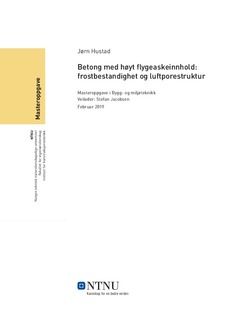| dc.contributor.advisor | Jacobsen, Stefan | |
| dc.contributor.advisor | Shpak, Andrei | |
| dc.contributor.author | Hustad, Jørn | |
| dc.date.accessioned | 2019-09-23T14:00:11Z | |
| dc.date.available | 2019-09-23T14:00:11Z | |
| dc.date.issued | 2019 | |
| dc.identifier.uri | http://hdl.handle.net/11250/2618290 | |
| dc.description.abstract | Produksjon av sement og betong medfører store CO2-utslipp. I de fleste land i verden foregår et intensivert forsknings- og utviklingsarbeid rettet mot mer miljøvennlige løsninger. Mange av disse løsningene er i tidlige stadier og mer forskning kreves på mange områder. Løsningen på kort sikt vil derfor være å erstatte deler av sementklinkeren i den ferdige sementen med erstatningsmaterialer.
I dag er økt innblanding av flygeaske i sementen det viktigste potensielle virkemiddelet for økt reduksjon av CO2-utslipp. Flygeaske er et biprodukt fra forbrenningsprosessen i kullfyrte kraftverk. Miljøgevinsten ved å erstatte sementen med flygeaske er knyttet til utnyttelsen av flygeaske som restprodukt, samtidig som sementmengdene reduseres.
Dersom man øker mengden av flygeaske i betong for å redusere miljøbelastningene, oppstår det noen praktiske problemer som krever ingeniørløsninger. På grunn av tregere hydratisering og økte vanskeligheter med innblanding av luft for denne betongtypen, er frostbestandighet en av faktorene som kan påvirkes negativt hvis dette ikke tas hensyn til.
Masteroppgaven vil derfor undersøke bestandighet av betong med høyt flygeaskeinnhold i salt/frost-testing (avskalling, indre skade og væskeopptak). Arbeidet er en del av et pågående forskningsprosjekt (DACS) støttet av Norges Forskningsråd og Norsk Industri. En serie betonger med høyt flygeaskeinnhold, med og uten lufttilsetning, blir undersøkt i laboratoriet med hensyn til frostbestandighet og luftporestruktur (L, α og totalt luftinnhold) i herdnet betong.
Frostbestandigheten måles i fryse/tine-prøving i henhold til CEN/TS 12390-9, modifisert med målinger av væskeopptak og indre skade (UPV, dilatometri). Luftporestrukturen måles med bildebehandling basert på ASTM C457, men modifisert i henhold til Fonseca & Scherer (2014) med planslip impregnert med tusj/bariumsulfat.
Resultatene fra denne studien viser at bruken av luftinnførende tilsetningsstoff, samt vann-bindemiddelforholdet er de viktigste parameterne hva gjelder betongens frostmostand. Betongblandingene med lufttilsetning og 35 % flygeaske som erstatning for sementen oppnådde gode resultater når det gjelder frostmotstand og tilfredsstilte gitte krav. Av resultatene fremgår det også at kun betonger uten luftinnføring hadde en indikasjon på intern frostskade.
Resultatene indikerer at det er mulig å produsere betonger med høyt innhold av flygeaske med tilstrekkelig frostmotstand i henhold til gjennomførte laboratorietester. Av studien fremgår også viktigheten av en god luftporestruktur sett i sammenheng med frostpåkjenning. Luftinnføring med tilhørende luftporestruktur er derfor viktige aspekter som må tas ekstra godt hensyn til ved produksjon av flygeaskebetong. | |
| dc.description.abstract | Cement production is a major source of CO2 emissions worldwide. Because there are few new technologies that can reduce CO2 emissions from the manufacturing of Portland cement, the answer lies in minimizing the output of cement clinker. In other words; CO2 emissions related to cement production may be reduced by replacing part of the clinker with other materials.
Fly ash has so far been the main material parameter to reduce environmental burdens from cement- and concrete production. Although other material and production solutions are at early stages of research and development, use of fly ash is for the time being the most operative solution for the concrete industry.
When increasing the amount of fly ash in concrete to further reduce environmental burdens from production and use of concrete, some practical problems occur that need engineering solutions. Due to the slower hydration and increased difficulty with entraining air voids in this type of concrete, frost durability is one of the concrete properties that can be impaired.
This master thesis will therefore investigate the performance of high-volume fly ash concrete in salt-frost testing and the associated air void structure. The work is part of an ongoing research project supported by The Norwegian Research Council (DACS) and Norwegian Industry. A series of concretes with high fly ash content with and without air entrainment are investigated in the laboratories with respect to their air void structure and performance in frost testing.
The frost test is in agreement with the reference procedure in CEN/TS 12390-9. In addition, a number of laboratory tests were carried out in order to determine the concrete characteristics. These tests include measurements of ultrasonic pulse transmission time through the specimens, as well as absorption and dilation measurements. The air-void characteristics of mixtures were also studied using automatic image analysis.
The results from this study shows that the existence of entrained air and the water/binder-ratio are the main parameters influencing the resistance of concrete to external salt-frost damage. Furthermore, the concrete mixes with 35 % fly ash as binder with entrained air and water/binder ratio of 0.45 and 0.29, has good resistance to internal and external frost damage. In general, internal damage is observed only for concrete qualities without entrained air.
The overall results indicate that it is possible to design high volume fly ash concrete composition with an adequate salt-scaling resistance under laboratory conditions. Frost durability of concrete is closely related with the air-void parameters. Therefore, a lot of attention must be paid to the applied AEA dosage and the resulting air void system. | |
| dc.language | nob | |
| dc.publisher | NTNU | |
| dc.title | Betong med høyt flygeaskeinnhold: frostbestandighet og luftporestruktur | |
| dc.type | Master thesis | |
